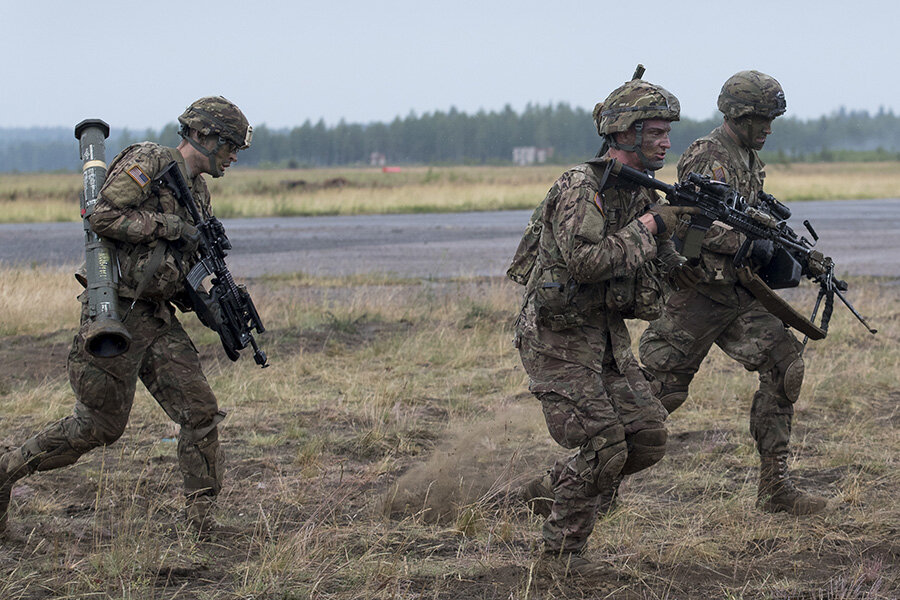Boot camps for the mind? Pentagon aims to build super soldiers.
Loading...
| Washington
Before they take a perfect or near-perfect shot, expert sharpshooters make fine adjustments, often without realizing it. Their breathing slows. So does their heart rate.
They enter “a very focused, calm, engaged state – almost at will,” says Amy Kruse, chief technology officer at Cubic Global Defense, which designs combat-training systems.
The question for military researchers is whether novices can tap into this mental “zone” before hitting the firing range, dramatically accelerating their learning curve. That premise is part of an ongoing effort by the United States military to create its own brand of “super soldiers” who can shoot better, make life-or-death decisions more quickly and accurately, and even recover more effectively – even joyfully – from wounds of war.
To do all of this, the Pentagon is delving into the nexus of biology and technology, experimenting with skin tattoos and wearable devices the size of a small bandage.
Monitoring fatigue
While soldiers in an all-volunteer force tend to start their military careers with a fair amount of motivation, they hit plenty of roadblocks along the way.
In basic training, for example, heat exhaustion remains a mighty feller of recruits. Wearable devices can help pick up markers in sweat and monitor recruits, letting instructors know when they could, say, use some Gatorade.
Wearable devices are also being used to sense fatigue in highly-trained Special Operations Forces, who tend to be loath to admit when they are bone-tired.
“You’re putting a team of six people together. Is this person ready to go, or not?” asks Rajesh Naik, chief scientist at the 711th Human Performance Wing at the Air Force Research Laboratory at Wright-Patterson Air Force Base in Ohio. “Maybe [an operator] just got back from another mission. They’ll never say, ‘No, we’re not ready to go.’ ”
Such devices, he adds, could help commanders make decisions about who to send on a mission, and who to keep back.
Since being a “super soldier” requires a high level of alertness, Defense officials also want wearable devices that can also help better tailor training exercises. This is perhaps most important when it comes to helping them make split-second decisions about using deadly force.
What do soldiers see?
While at the Pentagon’s futuristic Defense Advanced Research Projects Agency, Dr. Kruse and her team were able to to show that there are considerable differences between novices and experts when it comes to accurately gauging whether someone is a threat.
Now at Cubic, Kruse can monitor how trainees breathe, where their eyes are looking, how they point their weapons, and what position they are in as they go through a video course.
“We can actually say … ‘Dude, you weren’t even looking at the right spot. The guy was yelling, and you were looking at his face, not his hands.’ ” Kruse says.
Researchers say they can also tell whether trainees are actually taking in what they’re seeing. “You can say, ‘Sweetheart, I looked at your brain activity, and you didn’t absorb any of that,’ ” Kruse says
It is helpful that people are more open to this sort of feedback than they might have been in the past, she adds.
“I think in general the whole population is more comfortable with data about themselves. Ten years ago, if you told someone you wanted to measure performance, they worried, ‘You’re just going to tell me I’m not fit for duty, or I can’t fly,’ ” Kruse says.
“Today, we’re looking at it from a very positive perspective. We train our bodies, and I think people are coming around to the idea that there’s a corollary in that cognitive – and even emotional – domain.”
Sometimes that feedback can show, too, that soldiers are overly and unhelpfully alert. After a year-long tour-of-duty, for example, “You’ve been overtrained to survive,” Kruse says. “You just spent your tour looking for threats everywhere. But now you’re back in your hometown.”
Joy and recovery
Other researchers are taking on questions that seldom crop up in the soldier lexicon, including whether recovery from injuries can be enjoyable, or even beautiful.
"Patients are just given these bleak, second-rate experiences all the time,” says John Krakauer, director of the Brain, Learning, Animation, and Movement (BLAM) Lab at Johns Hopkins University. “But why not have a wonderful time?”
So Krakauer’s team designed a video game that turns physical therapy into a game and transforms patients into dolphins. They spend two hours a day using a robotic exoskeleton attached to their arm or leg to move dolphin fins on-screen.
The key is making movement fun, even when it’s difficult, and the feedback has been overwhelming. "One of the things that took me by surprise as a clinician is how joyous and tearful and thankful patients were to be given this kind of experience,” Dr. Krakauer says.
Krakauer has begun to explore the connections between a physical therapist teaching an injured patient to move and a coach teaching an athlete to be a really good mover.
In sports, “we know that there’s something about being beautiful and immersive that is important, that has a whole tradition,” he says. In physical training, military or otherwise, “something, somewhere is going untapped.”








